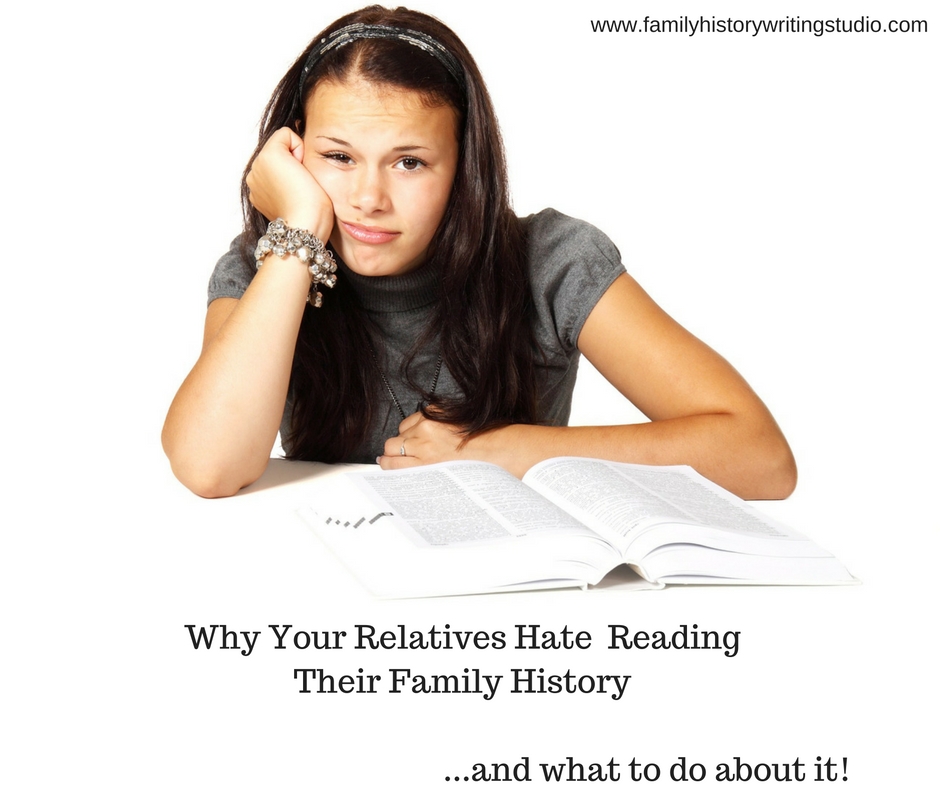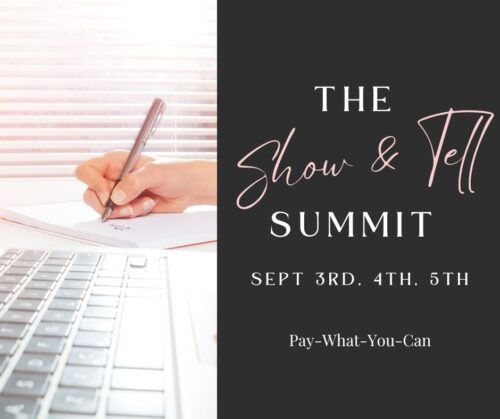Show, Don’t Tell you’ve heard it from me, perhaps other writing teachers, in books and on blogs across the internet. But what does it really mean? In today’s Storylines, we look at the difference between showing and telling, along with where to use it in your stories. We’ll also tell you all about the upcoming Show & Tell Summit and how it is going to answer all your questions.
How to Really Understand Showing and Telling
1 thought on “How to Really Understand Showing and Telling”
Comments are closed.
Related Post

5 Tips for Writing a Family History that Entertains Like a Movie5 Tips for Writing a Family History that Entertains Like a Movie
Most of us start writing our family history as summary. Summary is not a bad thing, and it serves a purpose in our family history stories. However, it is only one part of the equation.
Narrative Nonfiction = Scene + Summary
Eventually, we realize that to engage our family in our story and thus their family history, summary is not enough. We must entertain as well. It’s then that we must develop our knowledge of narrative nonfiction – the writing of true stories.
One aspect of narrative nonfiction that beginning family history writers struggle to understand is the difference between scene and summary.
What is Summary?
Summary, by its very name, encompasses a significant amount of information in a condensed form.
Summary is also known as exposition, and it is condensed narrative covering perhaps many events in just a few sentences, sparse details and may transcend a considerable amount of time. Summary is useful for going over information that we need to know but is not as exciting but still may be necessary to understand the story. Most times, the beginning family history writer overuses summary, often to the point of exclusivity.
What is Scene?
A scene, however, is an event, place or action that the reader experiences first-hand. In a family history story, a scene is an event chosen from your ancestor’s life retold in the fullness of time and place. Scenes are the ultimate tool for showing and not telling. A scene is a single, specific setting that creates the event as an experience for the reader. A family history scene is constructed from the documents of an event. The details are filled in with historical context, social history, eyewitness account and or diaries and letters. (If you’re lucky enough to have them. Most of us will piece together a scene through documents and social history. While you can write a great story that is all scene and no summary the reverse is not true. All summary and no scene makes for a very boring story.
Think of the difference between scene and summary this way. It’s the difference between being told about a car accident (summary) and watching it happen before your own eyes (scene). You may be able to imagine how horrible it was if someone tells you about it, but when you see it happening first-hand, you never forget it.
The best way to write a scene that will engage and entertain your readers is to think of your writing cinematically. Like movie playing in your mind’s eye. Of course, just thinking in your mind’s eye is one thing, getting it down on paper is a whole other matter.
Here are five tips for writing a scene that will entertain your readers like a movie.
5 Tips for Writing a Scene Like a Movie
1. Slow down. Don’t cram ten years into one paragraph, pick a single moment, a single event in your story and show it happening.
2. Make sure the event you choose is important, pivotal and will reveal relevant information about your ancestor or the story.
3. Show your ancestor in action either through physical movement or with dialogue or both.
4. Set your ancestor in their surroundings using all the senses. There should sights, sounds, smells even taste and touch if relevant.
5. Give the reader insight into your ancestor’s personality and state of mind through their actions, the look on their face, their voice and the words they speak.
When we take the time to learn to write a scene as part of narrative nonfiction, to show the crash rather than tell about it, we transform our family history stories into an experience for the writer and not a summary of facts.
Learn how to take an event in your ancestor’s life and bring it to the page in the Masterclass.

Why Your Relatives Hate Reading Their Family HistoryWhy Your Relatives Hate Reading Their Family History
Does your family object to reading their family history? Do you get the big eye roll when you offer them a story you wrote or an opportunity to preview a book your writing? Our families are completely uninterested in reading their family history. Many of us struggle with this. I know I did. Then I learned about writing scenes and about how the right balance of scene and summary can bring an ancestor to life on the page. When you learn the skill of writing scenes your stories become entertaining and compelling all the things necessary to engage your family and hold their interest.
What is a Scene?
Scenes are action, they usually include dialogue, description, conflict, thoughts, and feelings. When we read them, they are meant to play out like a movie in our brain. When we write nonfiction stories, we intermingle scenes with summary.
What is Summary?
Summary is just as it states it is an account of an event or time. The reader is given information in a brief format to move the story along. Sometimes summary will cover a span of years to speed up a story or fill in background information to add depth to a story. As family historians, we fall into the trap of writing everything, our entire story, in a summary format. This why our stories are boring.
We need to learn the skill of writing scenes and then to find the right balance of scene and summary to lay out a story.
How do we take a document like a passenger list or a marriage certificate or the birth of a child and bring it to like on the page? How do we but our reader there and allow them to experience the event as if it is playing out before their eyes – using scene.
When we combine scene with narrative summaries, we are writing creative nonfiction. That term creative nonfiction tends to scare many. They feel they are moving away from the facts and making things up. But that is entirely wrong. Creative nonfiction is taking the facts and laying them out on the page using scene and summary – using the tools of fiction writers while writing true stories.
Regardless of whether you are writing a family history narrative in third person or a memoir in first person scenes should be a part of your writing formula. Irrespective of whether you are writing a family history in a short story format or an epic novel you need to be using scene and summary to capture and hold the attention of your readers.
What is a family history scene?
How does a scene that you read in a novel differ from a family history scene you would read in a family history story? A family history scene takes an event in your ancestor’s life, getting on a ship to America, voting for the first time, giving birth, getting married, proposing to their spouse or signing the documents to own their first acre of land and then using action, dialogue, description, conflict, and emotion bring it to life on the page.
As family historians, we collect information about this event, information that we garnered from our research, our documents, information from interviewing those who were present at the event or have heard stories of the event. With those facts in hand, we take it one step further, we put the event within a social context of the place and time –we do some social history research. We set the stage by painting a setting of where the event was held. We describe it in detail giving it life.
Next, we put the characters into that setting, our ancestors. How did they look and act? Human nature, diaries, interviews and the actions of our ancestors will give us plenty of insight into the behaviours and motivations.
As I have suggested, a family history scene is born out of the records we have acquired in our research. Research we have identified and analysed and then interpreted into a scene in our story. We make it clear to the reader the facts versus our speculation.
Sounds easy right? Well for some it does come easy and for others, it takes some practice, actually, for most, it takes some time to learn the skills and then to practice those skills. But once you have the knowledge of scene writing you’ll never turn back to strictly writing a dry narrative summary.
Do you want to learn the skill of scene writing?
It’s not enough for me just to tell you what constitutes a scene and how it will transform your boring stories into  entertaining stories. The real learning comes in building scenes. I wanted to help writers acquire those practical skills of scene writing so I created an online workshop, Writing a Family History Scene. In this 6-week course, we work through each element building a robust scene one you will be excited to say you wrote.
entertaining stories. The real learning comes in building scenes. I wanted to help writers acquire those practical skills of scene writing so I created an online workshop, Writing a Family History Scene. In this 6-week course, we work through each element building a robust scene one you will be excited to say you wrote.
Here’s what some past students have said about this course.
Kim Said:
I thoroughly enjoyed completing this course in “Writing a Family History Scene” and would recommend it to all aspiring family history writers. It is inspiring when you can see yourself and your fellow students improve so much by the end of the course. Lynn’s teachings have given us the tools to carefully craft our stories for the enjoyment by our families. I have learned so much.
Denise Said:
This course opened my eyes to scene structure. My writing improved immensely once I had the right tools and guidance to build a scene properly. This is my second Family History Writing Studio course, and it will not be my last. Between Lynn’s excellent guidance and the input from the other students, it was an interactive learning experience I highly recommend to anyone who is thinking of writing a family history narrative. In order to do any job properly, you need the right tools and, in my opinion, this is the place to build your toolbox.
If you’re ready to write a non-boring family history story, then join us for Writing a Family History Scene.

As I was listening to you talk about Show/Tell it helped me to see why I am having trouble with my heirloom stories. I am only telling and I see the potential to make it so much better with showing. Didn’t we do this in school? Show and tell. It was always interesting to see what someone would bring to class to ‘show’ and tell about. I would love to do this class.